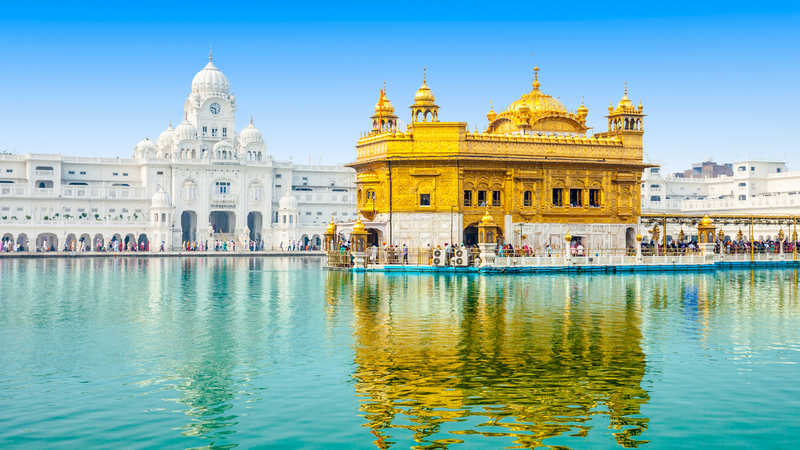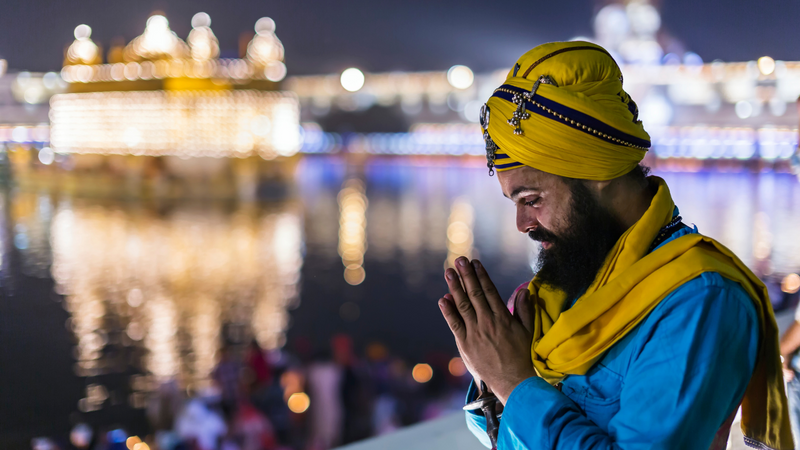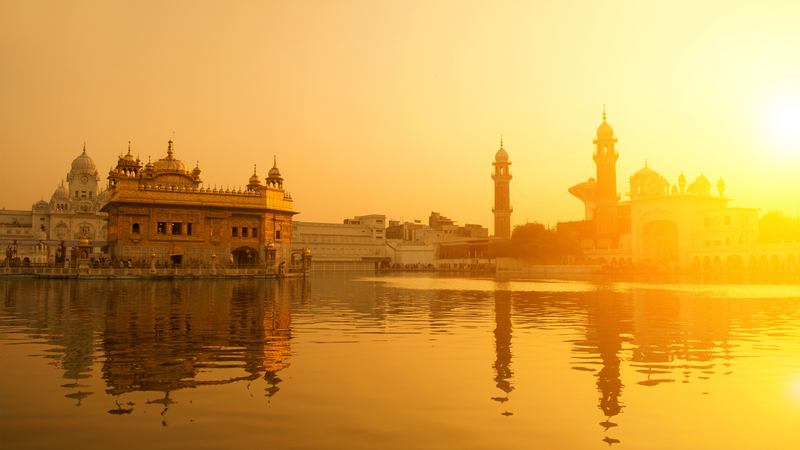Amritsar - a city that embodies the spirit of Punjab and the Sikh community. This city is home to one of the most sacred places for Sikhs, the Golden Temple in India, which is a must-visit for anyone who wants to experience Punjab's rich cultural and spiritual heritage.
The city's name, Amritsar, translates to "holy pool of nectar," and it's not hard to see why. The Golden Temple in India, also known as Sri Harmandir Sahib, is a marvel of architecture and design. It is a stunning structure made of marble and gold that seems to glow in the sunlight. The temple is surrounded by a beautiful pool of water, the Amrit Sarovar, which is said to have healing powers.
So, If you're looking to embark on a journey to some of North India's most captivating destinations and seeking an unforgettable experience, then the Golden Temple Amritsar tour should be at the top of your list. This comprehensive guide gives you everything you need to get the best out of your Amritsar travel. So, without further ado, let's get started and uncover the magic of the Golden Temple.
What is the Golden Temple?
The Golden Temple in India is a Sikh Gurudwara and is also known as Harmandir Sahib.
History

Legend has it that Guru Nanak, the founder of Sikhism, visited the site in the 16th century and declared it blessed. Over the years, the temple had undergone many renovations, including one in the early 19th century when Maharaja Ranjit Singh covered it in gold plating, giving it its distinctive appearance.
But the temple's history is not all rainbows and sunshine. It has also been the site of significant events, such as the Jallianwala Bagh massacre in 1919, where hundreds of peaceful protesters were killed by British troops. Despite these challenges, the Golden Temple remains a symbol of Sikhism and a shining example of faith, community, and service. It's truly an inspiring place that reminds us of the power of faith and compassion to unite people.
Exploring the Golden Temple in India

Sanctum: The inner sanctum of the Golden Temple in India is a place of great reverence and holiness for Sikhs worldwide. Here, the Guru Granth Sahib, the holy scripture of the Sikhs, is kept under a golden palanquin. The atmosphere is one of deep devotion, with the sound of hymns and prayers filling the air. It is a place where visitors can connect with the divine and feel a sense of peace and tranquillity amid the bustling temple complex.
Sarovar: The Golden Temple sanctum is surrounded by an artificial pool or Sarovar that is believed to have healing powers. Separate bathing areas for men and women are available, where visitors can take a holy dip in the sacred water. It is a common practice among many religions, where pilgrims seek spiritual fulfilment and purification by taking a plunge into natural bodies of water considered sacred and have healing properties.
Parikrama: Parikrama, or walking around the Golden Temple, offers a peaceful experience for visitors. Many devotees can be found absorbed in recitation and prayer while basking in the Golden Temple's glory.

Langar or the community kitchen: In Sikhism, Langar is seen as one of the noblest acts of service. It is almost impossible to find a Gurdwara without some form of Langar. The Golden Temple in India runs an enormous public kitchen; it has been reported to offer free hot meals to around 50,000 to 100,000 people daily. When individuals come together for these Langar, all social classes are left behind, and everyone is equal; reverence is all you will observe in one of these communal meals.
Things to remember before your visit to the Golden Temple, Amritsar
Best time to visit Golden Temple
When planning your visit to the Golden Temple, it's important to remember the daily routine and schedule of activities within the complex. The temple is open 24-7, and visitors can enjoy the langar (community kitchen) anytime.
For an immersive and unforgettable experience, consider visiting during the early hours of the day. At 4:30 a.m., the Guru Granth Sahib is taken from the Akal Takht in another complex and paraded around the main shrine. This ceremony, known as the Palki Sahib Ceremony, is a beautiful and spiritually uplifting sight.
The day at the Golden Temple begins with the first hukamnama (order of the day) being read at 5 a.m. and ends with the last one being read at 9:45 p.m. By 10 p.m., the Palki Sahib (holy palanquin) with the sacred book has been taken back to its resting place. Throughout the day, visitors can witness prayers, kirtans, and readings from scripture at regular intervals.
While the temple is open throughout the day, the best time to visit Golden Temple may vary depending on your preferences. If you prefer a quieter and more peaceful atmosphere, consider visiting early in the morning. On the other hand, if you want to experience the bustling energy of the temple, consider visiting during the day when the daily routine is in full swing.
What to wear when visiting The Golden Temple in India

When visiting this sacred place, you must dress respectfully. There is no exact dress code, but some guidelines exist.
1. Everyone must cover their head - you can bring your scarf or bandana or borrow/buy one just outside the temple doors. Do not wear a hat as a substitute.
2. Cover your shoulders and legs - opt for a long dress or pants and a long top.
3. Shoes must be removed before entering the temple; shoe drop-off services provide tokens you need to keep to collect your shoes later on. Also, socks should be removed; the temple offers foot-washing facilities and pools where you can clean your feet upon entering and leaving.
4. When choosing what to wear, consider the season - it can get quite warm with many people inside, so light cotton is recommended.
5. Lastly, luggage must be left in the free storage room at the temple entrance; however, handbags and smaller backpacks can be brought in.
Some general guidelines to keep in mind
The Golden Temple happily welcomes all, but there are a few points to keep in mind to ensure a pleasant and respectful experience. These aren't hard and fast rules, but something devotees observe out of reverence. If you're visiting from out of town, be mindful of these guidelines for a hassle-free trip.
1. Smoking and drinking alcohol are strictly forbidden on the temple grounds and near the Golden Temple.
2. No meat or meat products are allowed in the area, and all restaurants around the Golden Temple are vegetarian.
3. When accepting Karah Prashad, the holy offering, take it with your right palm.
4. Please remember to switch off your phones before entering the sanctum.
5. If you wish to bathe in the Sarovar (pool of nectar), you can do so - no swimming is allowed - but be sure not to use soap or shampoo in this area; there is a room for wet clothes and washrooms where you can use soap and shampoo after.
6. People often donate money as a sign of respect or in search of blessings. You can do so by putting money in a deposit box near the perimeter or inside the sanctum or by contributing to the community kitchen - you will receive a receipt for your donation. There is no fixed amount; some give a Euro while others offer more; this money is used to operate and maintain the temple.
7. When walking around both the pool and the Golden Temple building, please move in a clockwise direction.
8. Free English booklets are available at a designated stall inside the temple premises - these are excellent guides for anyone seeking the answer to "what is Golden Temple?"
9. As you come in and out of these grounds, you must step into a water bath to clean your feet before continuing.

Guidelines regarding photography and videography
When visiting the Golden Temple, it's essential to be mindful of the rules and regulations regarding photography. While capturing the beauty of the temple is undoubtedly tempting, visitors are only permitted to take pictures from the Parikrama, the outer walkway. Photography with cameras or cell phones is strictly prohibited within the Golden Temple or the path leading to its entrance.
That said, photography in communal areas is allowed, but it's crucial to exercise discretion and show respect for the sanctity of the space. Avoid taking pictures of people bathing in holy water or consuming blessed food, as it is inappropriate.
It's worth noting that using social media platforms like TikTok and Instagram is also prohibited within the temple premises, so visitors should refrain from taking videos or photos for these purposes. Also, drone photography is prohibited, so leave your drone at home.
Remember, the Golden Temple is not just a tourist destination but a place of worship and utmost reverence for the Sikh community. By respecting and following the rules and regulations, visitors can help preserve the sanctity of this sacred site for generations to come.
The Golden Temple Amritsar tour is a once-in-a-lifetime experience that will leave you with lasting memories. We sincerely hope this guide has helped you plan your trip to this beautiful and sacred place. As you immerse yourself in the serene and spiritual atmosphere of the temple, you'll be struck by its beauty, tranquillity, and rich history. Alternatively, you can also visit during the sacred Amritsar festival.
But your exploration of Amritsar, the city of Golden Temple, shouldn't end with the temple. The town is famous for its mouth-watering street food, and the Amritsar food trail is an absolute must-try for any food lover. From spicy chaat and crispy samosas to buttery parathas and creamy lassi, the local cuisine will surely delight your taste buds.
So, welcome to Amritsar, the city of Golden Temple, which offers a perfect blend of spiritual and culinary experiences. Make the most of your visit by taking in the sights and sounds of the Golden Temple and indulging in the city's delicious food. Whether you're a seasoned traveller or a first-time visitor, Amritsar and its charms will surely capture your heart.
Disclaimer: The details mentioned throughout this blog are sourced from publicly accessible platforms. At Zeezest, we intend to share factual and verified information. Should there be any inconsistencies or variances in the information provided, please understand that these are entirely unintentional and not meant to mislead.




